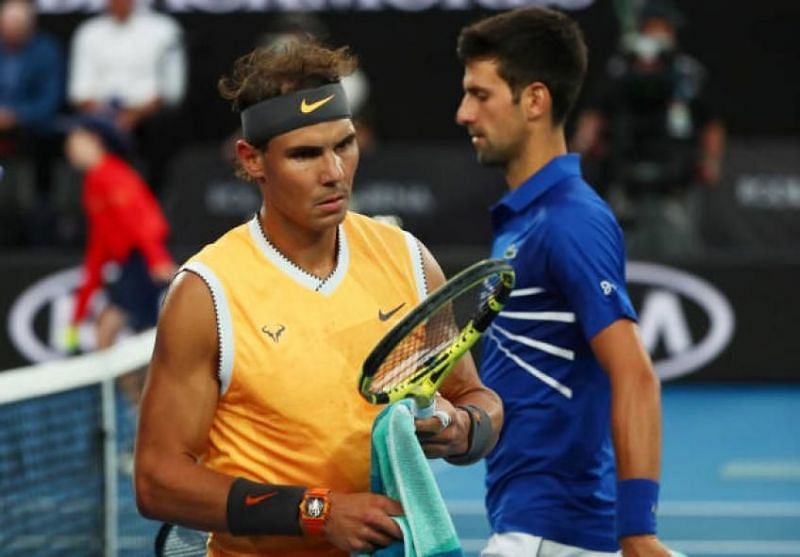
Eye-opening stats reveal why Rafael Nadal struggles against Novak Djokovic on hardcourt
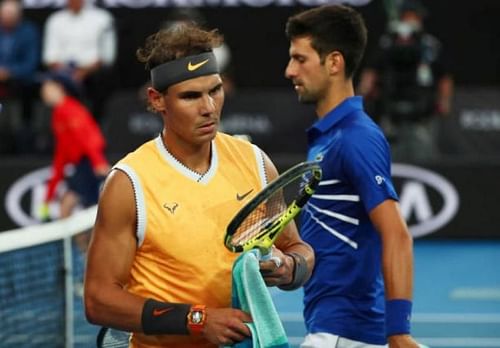
Whenever Novak Djokovic has clashed with Rafael Nadal over the last 10 years, it has been at the crest of a tidal wave of tension. Every match in the rivalry in the 2010s has been a high stakes one; it wouldn't be wrong to that Nadal vs Djokovic has been the fight of the decade.
Rafael Nadal and Novak Djokovic are both so similar and opposite in their nature that their rivalry has left many fans befuddled. While Novak Djokovic is robotic and precise in his play, Rafael Nadal is laborious and cussed. And yet both players have a certain "animalism" in their play which has set the rivalry apart from all others.
Rafael Nadal had the upper hand over Novak Djokovic in the late-2000s, but the Serb turned the rivalry on its head at the turn of the decade. Djokovic has won 22 of their last 32 encounters, and now has a significant lead in the overall head-to-head.
Their recent matches on hardcourt have been particularly lopsided. Djokovic has won the last nine matches he has played against the Spaniard on hard, and hasn't even conceded a set in any of those contests.
Rafael Nadal has found it extremely tough to make breakthroughs against the current World No. 1 on the surface; his last hardcourt victory over Novak Djokovic came way back at the 2013 US Open.
A quick look at the detailed stats of their hardcourt matches makes it very clear why Rafael Nadal has been so helpless lately while facing Novak Djokovic. While several different features of their respective games play a part in the dynamic, it all starts with a single - and what many claim most underrated - shot.
The answer lies in Novak Djokovic's serve
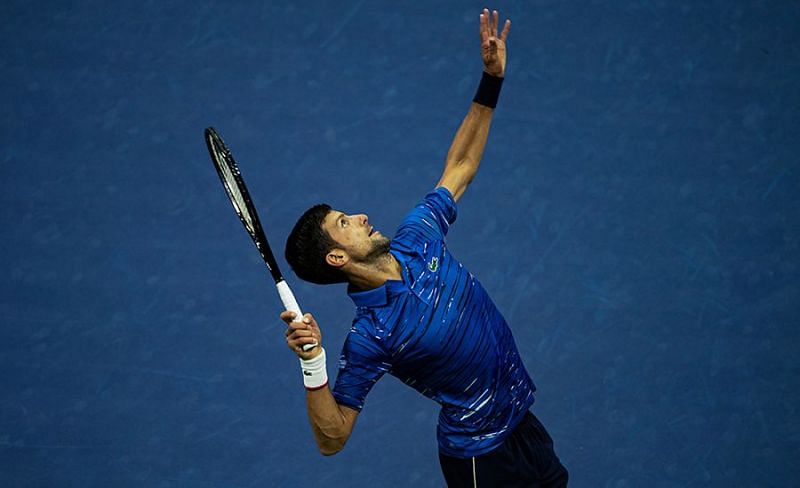
The serve is easily the single most important shot in tennis, and when executed correctly it can make a huge difference to any result. But how do we determine the extent of its value? This is where Match Charting Project by Tennisabstract.com comes in.
The Match Charting Project offers a lot of data on different parts of the game. And the numbers behind Novak Djokovic's performance vs Rafael Nadal, compared to his career averages, are extremely revealing.
On hardcourt, Novak Djokovic boasts of a better second serve win percentage vs Nadal - 58% - than he does against the field as a whole - 56.1%. Djokovic has one of the best second serves in history, but the fact that he is more effective with the shot against Nadal (who is one of the greatest serve-neutralizers ever) than he normally is, is a huge eye-opener.
Novak Djokovic also performs better on his ace rate vs Rafael Nadal on hard than he does against the whole field. He wins about 8.2% of his service points with an ace against the Spaniard, while his career average is a significantly lower 7.4%.
The Serb is also nearly equal on holding percentage and service points won vs Nadal as he is vs the whole field.
The numbers show how Novak Djokovic has consistently been lifting his game in one key aspect against Rafael Nadal on hardcourt. The Serb is already pretty effective with his serve in general, but when pitted against the Spaniard on his favorite surface, he raises the efficiency level of the shot even higher.
Rafael Nadal is not able to do enough with his return
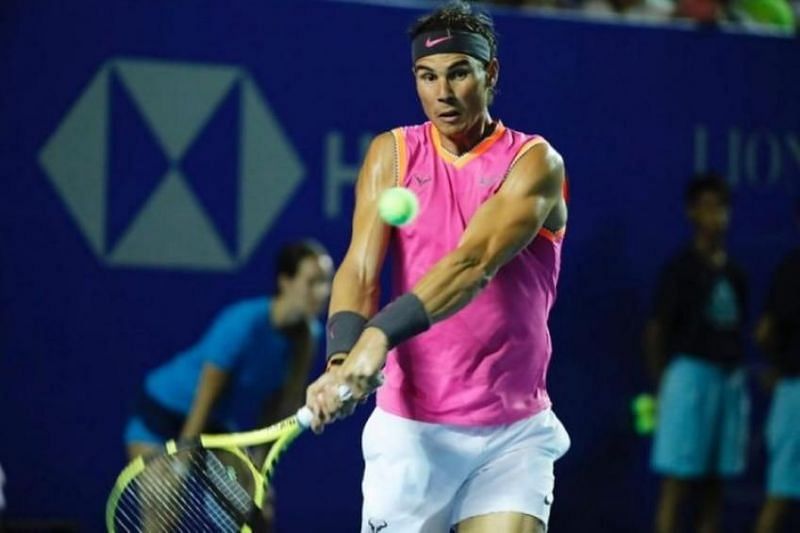
Rafael Nadal is not widely known for his return of serve. He is often found standing way behind in the court, which prevents him from taking the ball on the rise and hitting an aggressive return. However, Nadal still manages to get good depth on the shot, especially by imparting loads of RPMs on his topspin-heavy forehand.
But while Nadal is one of the best in the world at putting the return back in play and winning the point over the next 2-3 shots, he is just not able to do that often enough on Novak Djokovic's serve.
Rafael Nadal breaks at a staggeringly low rate of 14.3% vs Novak Djokovic on hard, which is miles below his career break rate average of 30%. In other words, Nadal is less than half as good with his return against Djokovic as he is against the field as a whole.
Novak Djokovic has one of the best down-the-T serves in tennis, but that doesn't explain why Nadal fares worse than the rest of the field against it. The stats suggest there's a mental aspect to this imbalance; it seems Nadal is too tentative with his return of serve against Djokovic, which costs him big time.
The "backwards" nature of a lefty playing a righty also plays a role in this dynamic. Nadal is forced to hit a few more backhand returns than his right-handed peers, because of how prevalent the wide serve is in tennis.
This small detail blows up to big proportions against a terrific server like Novak Djokovic. Nadal can't rely as much on his forehand as other right-handers, thus leading to poorer returning numbers vs Djokovic compared to the field.
Nadal does better against Federer's serve than he does against Djokovic's
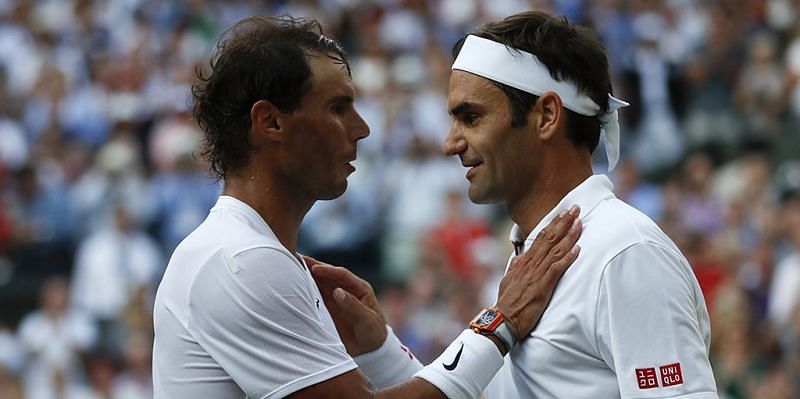
The numbers look particularly unusual when you consider that Novak Djokovic is not often counted among the best servers in the world. But here's something even more strange: Rafael Nadal performs much better against Roger Federer's legendary serve on hardcourt than he does against Djokovic's serve.
Federer is widely regarded as one of the best servers in history, but Nadal has a break rate of 19% when he's up against the Swiss - as opposed to 14.3% vs Djokovic.
Nadal's down-the-line backhand is worth mentioning here, as it can possibly explain this anomaly in the Spaniard's numbers vs the Federer and Djokovic serves. As pointed out earlier, Nadal hits a few more backhands than his right-handed peers due to his left-handed play - and a good part of those backhands are aimed down the line.
Right-handers go down-the-line on 16.9% of their backhands from the backhand corner, while lefties do so 21.4% of the time. Nadal in particular goes down-the-line 24.4% of the time - more than any other active left-handed player.
On Roger Federer's service games, Rafael Nadal tends to target Federer's backhand right from the start of the point, a tactic he has used to gain ample dividends in their rivalry. This has a lot to do with Federer's relatively underpowered backhand when faced with Nadal's topspin, and it puts a lot of pressure on his serve.
These dynamics are just not the same when Rafael Nadal is up against Novak Djokovic, who boasts of arguably the most potent backhand in the modern era. Nadal's down-the-line backhand is almost invariably met with the powerful crosscourt backhand of Djokovic, which allows the Serb to retain control of the rally.
That forces Nadal to try and use his inside-out forehand more, which in turn gets him out of position and at the mercy of Djokovic.
There are a lot of such technical aspects that help explain the dynamics of the Rafael Nadal vs Novak Djokovic rivalry on hardcourt, but as the stats show, they all boil down to one thing. Djokovic holds all the aces - both literally and figuratively.